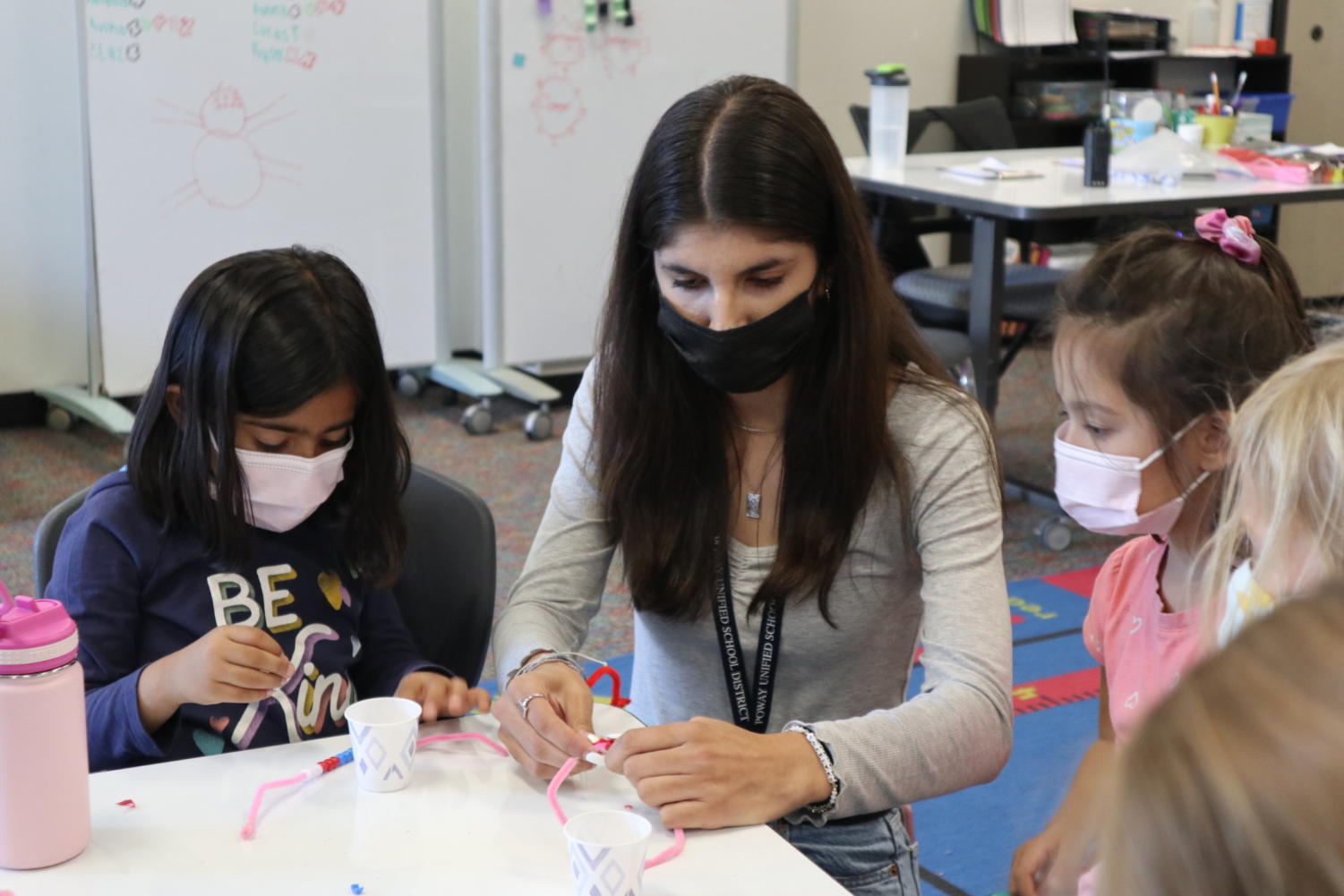Students work at ESS, forge new connections
October 29, 2021

Niki Tarighati (12) walked onto the Design 39 campus with the sun high in the sky. As she is greeted by the shouts and giggles of over 40 kindergarten-aged children, she took a deep breath and tried to crack a smile. On any other day, Tarighati would have been ecstatic to work with the children, but today, she was having an off day. Still, she got right to work. She collected the kids from classrooms, gave them their snacks, watched them on the playground, led an arts and crafts session, and so much more. Tarighati was about ready to collapse. She watched the clock; it was 4:30 and almost all the kids had left. As she started to clean up and end what was a long day, she was stopped by one of her students. He handed her a note and left. As Tarighati read the note, she felt the stress that weighed down on her shoulders lighten. “Dear Ms. Niki, I hope you have a good day.” Tarighati smiled as he walked away, not needing to try for this one.
This is why she works at ESS. This is what she signed up for.
All throughout elementary school and middle school, Tarighati spent her afternoons and summers at Extended School Services (ESS). ESS is a before and after-school program where students are provided with a safe and supervised place where they can participate in a variety of creative and educational activities. Because of her personal experience with ESS, she said it has always been a special place, one where she has long felt welcomed and accepted. “When I was a kid, ESS was a place to hang out and have fun during summers or after school,” Tarighati said. “It was just a place of community for me. The environment was always super welcoming and cool so I always knew I wanted to work there.”
As a senior in high school, it has been more than four years since she last attended ESS as a student. Now, she works as a high school ESS aide with TK and Kindergartners after school every day from 2:45 to 5:45 p.m.
She starts off her day by setting up snacks for the children, getting them from their respective classrooms, and helping students settle into ESS. According to Tarighati, the beginning of the workday is typically the most difficult.
“The hardest part about working at ESS are the transitions,” Tarighati said. “Trying to get the kids to listen to what you’re saying is always difficult. I feel like we have a talk every single day about listening. It’s just hard because, at their age and dependence on their devices, they are always distracted.”
Despite how distracted the kids might be, Tarighati has only had pleasant experiences with working at ESS.
“I love working with the kids,” Tarighati said. “It’s just super fun because they’re always so high energy and I get to try and match their energy, which makes my day better.”
The positivity Tarighati experiences at ESS is not unique to her. Tina Khadem (12) and Meagan Clay (12) have also loved their time working at ESS together. Khadem has worked at Sunset Hills ESS since May while Clay began working at Sunset Hills in August. According to Khadem, both she and Clay have experienced much more from their job than they expected when they signed up to be a high school aide.
“I was surprised to see how much training was required for ESS,” Khadem said. “We had behavioral training, which helped teach me more about kids and about how there are a lot of important things that you should think about when you work with kids. [These sessions] are like a class we have once a month to learn more about working with kids.”
While Khadem aims to become an engineer, she still finds these training sessions and everything else she does at ESS to be helpful for the future. She said the interpersonal skills she is gaining through working with children can be valuable in any profession. As for Clay, the benefits of working at ESS align specifically with her desired career path.
“I want to be a physical therapist who specializes in treating children, a pediatric physical therapist,” Clay said. “I feel like working with kids now will help me with that later. ESS is a good job to start with to gain some experience.”
Despite having everything planned out ahead of time, Clay said that working with children means you never really know what you will be dealing with that day, especially considering the children’s constantly changing moods.
“When you work with younger kids like first-graders, you have to be perceptive and know what they’re feeling that day,” Clay said. “If you make a wrong move it can really affect their day. If they’re happy, you want to keep them happy. If they’re sad, you want to change that as quickly as possible.”
Despite the pressure working with children can bring, Tarighati, Khadem, and Clay all agree that working as high-school aides is still one of the best and least stressful jobs they could have.
“When you’re at ESS, it feels like you never make mistakes,” Clay said. “The kids are always laughing and happy so it feels like you can’t really do anything wrong even if you did mess up a little. It’s just a really forgiving work environment.”
ESS is also a job that allows them to express themselves freely without fear of judgment, according to Tarighati and Khadem.
“You get to put all your creativity and any energy you have into the kids,” Khadem said. “No one judges you there. The staff and all the kids are really nice so everyone is really welcoming.”
While Clay might not have attended ESS as a kid like Tarighati and Khadem, all three of them agree that working at ESS felt like the best way to give back to their community.
“ESS is such an important part of a kid’s social life if they [participate in the program],” Tarighati said. “I think being able to make an impact in that aspect of their lives and being someone they can look up to is super rewarding. There are so many different types of people and kids at ESS that you can interact with [and] I just really appreciate being able to form all these special relationships with people.”


